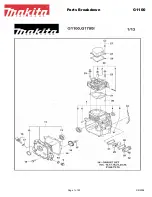
• (1) MiniGEN Unit
• (1) 12’ Propane Hose and Regulator
2
3
MiniGEN Unit
Installation Instructions
F
G
I
A
B
C
D
E
H
A) Wall mounting holes
B) Eye loops for hanging
C) Water inlet/outlet
D) Flame sight glass
E) Front panel
F) Power cord inlet
G) On/off switch
H) On/off indicator light
I) Gas inlet
Packing List:
1. (1) MiniGEN unit with
heat exchanger installed.
2. (1) 12' hose and regulator.
3. (2) Mounting screws .
4. Hose Clamps (not pictured)
1
• (2) Mounting Screws
Installation:
The MiniGEN can be wall mounted or hung by
chains. If wall mounting, secure the unit using the
two holes at the top. The unit must be mounted
securely and not just attached to the sheetrock.
Make sure that at least 1 of the screws is installed
in a stud. If hanging the unit by chains make sure
that they chains are securely fastened and are also
not just attached to the sheetrock. The unit must
be mounted at least 16" from the ceiling in your
room or hut. The unit must be hung exactly
upright or the anti-tip sensor will not allow the
unit to function. Make sure that the unit is not
installed in an area with strong air flow as it can
blow out the flame.
Attaching Gas Line:
Inspect the brass fitting and the brass inlet of the
MiniGEN for damage of any kind. If damaged DO
NOT USE. Otherwise, screw the brass fitting of the
supplied hose to the brass gas inlet on the MiniGEN.
This connection does not need teflon tape but
should be installed firmly. Be careful not to over
tighten. The gas line supplied has an attached
regulator with a plastic bottle fitting that MUST be
used. The bottle fitting is designed for 20lb and 40lb
propane bottles. Make sure that the valve on the
propane bottle is turned off completely by turning
it clockwise. Attach the other end of the hose to the
propane bottle by screwing on the bottle fitting. If
it doesn't easily attach you may be using the
wrong size bottle or wrong bottle type. Once the
hose is firmly attached, turn the valve of the bottle
counter clockwise to allow gas to flow. Check all
connections for leaks by applying soapy water to
the connections (including the regulator) and
looking for bubbles. If there are bubbles at any of
the connections do not use the product until the
leak is fixed. Also smell for gas inside the unit, if
you smell raw gas at all DO NOT USE (or discon-
tinue use).
Attaching Water Lines:
The MiniGEN heat exchanger has hose barb inlet
and outlets designed for 1/2" inside diameter
tubing. Slip the tubing over the hose barbs to
install. We recommend high quality kink resistant
tubing that should be secured with the supplied
hose clamps. Circulate water though the lines and
check for leaks before operating the unit.
Pump:
We recommend a pump with a flow rate of at least
500 GPH if you choose to water cool the MiniGEN.
Cooling:
You can use a small (5 gallon) reservoir with a
small chiller or, if you'd prefer not to use a chiller, a
larger reservoir alone (minimum 25 gallons;
depending on your application, a larger reservoir
might be required).
Removing the Heat Exchanger
(for use without the water cooling feature):
The MiniGEN is approved to be used with or
without water flow but we do recommend that
you remove the heat exchanger if you choose to use
it without water flow. Make sure the unit is not
running and has had ample time to cool off.
Unscrew the four screws and two brass nuts to
remove the front panel. Facing the heat exchanger,
lift either the left or right side and slide it out.
Reinstall the front cover after removing the heat
exchanger.
Attaching Power Cord:
The supplied power cord plugs in to the standard
120V power outlet of your CO2 monitor or a timer
(not recommended) and includes a 12v
transformer that supplies power to the MiniGEN.
Operating the Unit:
Once every step above has been followed, most
importantly checking for and correcting any gas
leaks, the MiniGEN is ready for operation. If
applicable, turn on the water and leave flowing
while the unit in operation. Make sure the propane
bottle is full and the bottle gas valve is on. Turn on
the power switch for the unit and make sure that
the power cord is energized by your CO2 monitor. If
the monitor outlet is powered on, the MiniGEN will
light, check the sight glass to verify. When the
powered outlet on the CO2 monitor is turned, off
the unit will turn off. (If the MiniGEN does not light
the first time there is probably air in the gas hose.
Turn off the power switch, wait 60 seconds, and
try again. This may have to be done several times
to bleed all of the air out.)
Condensation:
If during operation there is condensation collecting
on the lines and dripping out of the unit you must
raise your water temperature to the point that the
condensation stops. Condensation damage is not
covered by warranty and is a problem that should
be addressed immediately to avoid damage to the
unit. Condensation occurs when any object inside
your growing environment is colder than the dew
point temperature. The incoming water tempera-
ture must be above the dew point in order to curb
the problem.




















